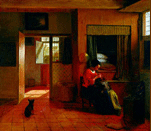










40.
Women and The Pedagogical Structures of Memory
Organizers:
Description:
Our topic is so wide-ranging and our own research so specific that we count
on participants to contribute the wealth of their learning and experience
to our discussion by introducing texts, themes and problems that complicate
our topic as we have briefly outlined it. We imagine, for example, that participants
may raise questions about women’s involvement with mnemotechnical practices
like songs and rhyming ditties, Ramist diagrams, memory theaters and genealogical
trees. But we also foresee that they may want to engage with memory in a larger
sense, as it manifests itself in relationships with mentors and pupils, between
mothers and children (e.g. in female legacy books), or between women and their
cherished fathers/husbands, whose memories they work to perpetuate. In fact,
we can imagine the conversation going in many directions—from the way
women appropriate strategies of memorial imitatio in genres as varied as epistles,
commonplace books, or rhetorical debates to their inversion and critique of
traditional methods for ordering memory like the Petrarchan blason or Ignatian
meditation techniques. We welcome information about the pedagogical methods
endorsed by women who ran schools or had tutees (e.g. Aemelia Lanyer).
Our own presentations are based on primary sources that we believe are unfamiliar and provocative enough to serve as a springboard for a fruitful sharing of ideas, viewpoints and examples. After a brief introduction, we will present our topics as follows:
Natasha Korda explores how memory systems position gendered subjects in relation to the material world by examining the figure of the housewife as a “Mistresse of Memorie” in early modern domestic treatises like Juan Luis Vives’s Instruction of a christen woman (1543) and William Gouge’s Of Domesticall Duties (1623). This figure genders the classical notion of the ordered places or loci of memory found in rhetorical treatises like Cicero’s De Oratore, the anonymous Ad C. Herennium libri IV, and Quintilian’s Institutio oratoria, appropriating the memory-system to a specifically oeconomic context. The housewife’s disciplined ordering of the household thereby becomes both a model for, and a reflection of, her disciplined ordering of her own mind. Domestic treatises are thus ordered in such a way as to facilitate the wife’s internalization, via memorization, of the disciplinary regimes they aim to institute. To be a good housekeeper, the wife must re-collect or internalize via memory the objects she is charged with keeping, and the places in which they are kept, so that she always knows where they are and has them ready to hand. This interiorized female oeconomy is depicted as perpetually anxious or fearful of that which is unseen and therefore, potentially lost.
Virginie Cassidy and Anita Sherman jointly present two literary prefaces that offer contrasting reactions to the humanist program of classical education. In the dedicatory epistle to her Evvres (1555), Louise Labé not only endorses learning, but recommends the satisfactions of writing to her female patron, in part by evoking the pleasures she takes in rereading herself and thereby returning in memory to a happy ‘scene of writing’ occupied in remembering. By contrast, Lucy Hutchinson late in life rebels against the excellent classical education that she had been privileged to receive. In the Preface to her epic poem, Order and Disorder (1679), Hutchinson rejects merely human pedagogical structures for memory: “It is a misery I cannot but bewail, that when we are young, whereas the lovely characters of Truth should be impressed upon the tender mind and memory, they are so filled up with ridiculous lies, that ’tis the greatest business of our lives, as soon as ever we come to be serious, to cleanse out all the rubbish our grave tutors laid in when they taught us to study and admire their inspired poets and divine philosophers” (4). Yet, even as Hutchinson resists exemplary epic poets like Lucretius (whom she had translated) and distances herself from Milton’s approach, she embraces the epic genre as a vehicle for a more godly account of Genesis. In passing, it will be noted that rehabilitating her husband’s memory is the central didactic purpose of her Memoirs of the Life of Colonel Hutchinson.
While showing several slides of portraits by Mary Beale, Brandi K. Adams will point out their artistic features and discuss how Beale memorializes herself as a painter, mother and wife. She will then ask the following questions as a way of turning the workshop over to discussion. How do Mary Beale’s self-portraits contribute to the notion of memory? How can we look at Mary Beale’s work in light of her master-teacher, Peter Lely? She is usually discussed as his female disciple, indebted to Lely for her style, subject matter, composition and palette. Can we as scholars evaluate her work on its own? Are all (male) students of painting in the Renaissance evaluated in terms of their teachers? What does this practice say about pedagogy and art? How might the relationship between Beale and Lely compare to similar pedagogical relationships in other fields, such as science and literature?
These abstracts have several interesting points of contact. For example, the memory of Mary Beale has been framed by a critical discourse that insists on positioning her in a genealogical niche below her beloved teacher and above her promising son. The figure of the “Mistresse of Memorie” reappears metaphorically in Hutchinson’s language about her desire to sweep the rubbish out of her mind and to replace it with an order based on Biblical reading. The pleasure Labé takes in returning to her literary work seems shared by Beale’s portrait of herself holding a palette. We expect our audience to help us develop and discover these and other points of contact.
Slides:
Preliminary Readings for Prior Circulation (total 18 pages):
Secondary Sources :
|
|
|
||||||
|
|
 |
 |
|
||||
 |
|
 |
|
||||
|
|
|
||||||
|
|
|
||||||
 |
|
||||||
|
|
|
||||||
| |
|
||||||
 |
|
||||||
 |
|
||||||
 |
|
||||||
 |
|
||||||
|
|
|
||||||
|
|
 |
|
|
||||
 |
|
||||||
|
|
|
|
|
|
|
|
|